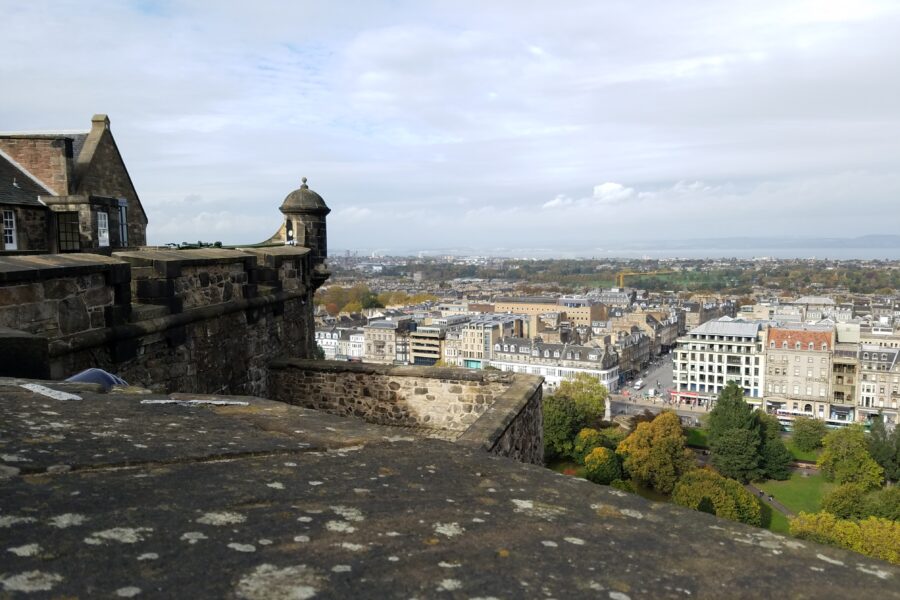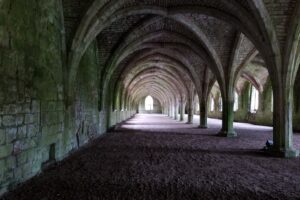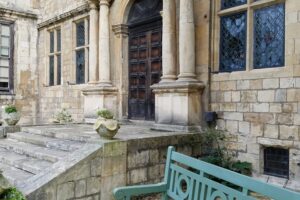After the short time we have been here we are better able to interpret the routes of the hop on hop off tour buses. We know we can be picked up across the Park that is Charlotte Square and dumped off somewhere close to Edinburgh Castle, cutting our climb at least in half, if not more.
We arrive at the stop just as the green tour bus pulls away. Biding our time, we wait for the next one by climbing the stairs to the government building which is part of the National Records of Scotland, looking, reading, thinking, talking, sheltering from the overcast skies that intermittently spit at us from above.
We exit the bus at the beginning—maybe the end?—of the Royal Mile with our guide’s Scottish accent reverberating in our ears, shouting the words, “Now that is a castle!” as he points out the towering fortress from below. He should have also pointed out the castle is a magnet to the hordes. Us included. Michael mutters, “This is like Disneyland.” There are a lot of people. We are able to walk past the long lines of individuals waiting to have their bags checked because I am too lazy to carry a purse. We also escape the ticket lines because we hold our pre purchased ones in our hot little hands—if only the warm part were true.
The Scottish guide at the castle wears an air cooling kilt and a heavy jacket to compensate, while he tells tales of attacks on the castle walls. Michael loves his stories, but his accent is heavy, his head is frequently turned away from my willing listening ears, so eventually we head back to the concession stand and purchase an audio guide, which we are told has four hours of history contained on the tiny recorder. I am happier. Michael is satisfied.
This fortress, built upon a defunct volcano appears to be totally invulnerable to attack. Who would dare? How could anyone scale the slippery rocks, much less the castle walls? My audio guide tells me it happened. More than once. It has been reduced to rubble by bombardment and rebuilt; little of the original castle remains. Under siege 26 times in its 1100-year-old history it is recorded as one of the most besieged places in Great Britain and apparently one of the most attacked in the world.


Volcanic Rock

I learn of warring kings giving birth to weakling sons who become kings as infants or at least mere children, and weakling kings living forever, giving birth to warring sons. Murder. Intrigue. Betrayal. Cruelty. Torture. All because you were born to parents considered royal. What in the heck is royal anyway? I’m beginning to believe it isn’t much—certainly not a right—just a cursed inheritance. As a little girl when I dreamed of castles I thought of sun-filled days, knights in shining armor, beautiful damsels and romance. I thought of Cinderella. How wrong can a little girl be?



I can’t keep all of the kings of England and Scotland straight, but I recognize the name Edward I, Hammer of the Scots—how could I possibly not remember Edward after our stay in Wales? The castle was under English control for 14 years till 1314 (7 years after Edward’s death). A nocturnal surprise attack of thirty soldiers was led by a single man who knew a secret route up the castle rocks—apparently discovered by his desire to be with his secret lover. They scaled the walls, subdued a few guards, then opened the gates to allow the majority of forces in to wrest the castle away from the English garrison, securing the fortress for the Scots.

At times the crowds make it difficult to hear, even with someone talking directly into my ear, and I find myself turning up the recorder’s volume. We wind our way to the very top of the fortress and finally happen upon the oldest building on the jagged peaks summit—St. Margaret’s Chapel from the early 12th century. It is tiny, so tiny, that with the crowds, we find it almost impossible to really see the interior, which is the story of almost each building we enter. The weather is miserable. There are tons of people. When is the off-season?



It seems each building we enter is a museum of sorts, all dealing with some form of Scottish history, but not all dealing with the land where we stand. I am confronted with information about more wars than I want to think about and when I read the following words concerning WWI it makes my heart sick.
“…The killing ground of fire-raked earth between opposing trenches became known as No-Man’s Land. Movement was nearly impossible. It became a war of attrition…
Nobody seemed capable of stopping a war that had lost any meaning after the first year.”
“Thanks to new military technologies and the horrors of trench warfare, World War I saw unprecedented levels of carnage and destruction. By the time the war was over and the Allied Powers claimed victory, more than 16 million people—soldiers and civilians alike—were dead.”

All I can think about is all of those very young boys. Dying. Maimed. Lives lost. Ruined. Every time I visit Europe I am reminded, if not taught anew, of the terrible wounds and scars and destruction that has been constantly wrought on this land and its inhabitants. It is more than sobering. It colors my mood. Maybe I should stop reading and listening. Maybe others should start.
After we see the Stone of Destiny, the Scottish crown jewels and the room where Mary gave birth to her son James in the Royal Palace, we call it a day. Even though we have covered all fourteen major points on our audio tour, and walked into and out of more buildings than I can count, I feel like I am leaving a dinner plate full of food.
Walking down the steep stairs we avoided on our way up to the towering fortress, we look for some semblance of nourishment in the Grass Market far below the castle walls.

After several abortive tries—the pubs are filled to overflowing this Saturday afternoon—we find one with a vacant table. Too late for lunch we order gin and tonic and crisps. They are out of crisps. Michael is directed down the street. Once he deposits our drinks on the tiny bar of a table, he goes in search of the only solid food available, telling me when he returns that he almost forgot which pub we are in on the way back.



Dinner reservations are hard to come by on short notice in a city filled with tourists, but last night I was able to obtain two at 5:45. Café Andaluz won me over immediately with the promise of Padron peppers, charred and salted. Arriving on time, we discover that the restaurant is huge; one of the largest we have been in on this entire trip. We order a tapas assortment from the two offered on their Menú Del Día for £24.90 pp which promises a taste of shrimp, scallops, chicken, beef, potatoes, olives, bread, a Spanish tortilla, jamon and cheeses. The Padron peppers—a must have—we order a la carte.
Walking back to our hotel in the cold dark night, pulling my coat tighter around me, we see that even though it is 55°F people are seated at the sidewalk tables. If it isn’t raining, it’s considered good weather in Edinburgh. I can’t believe we board the train back to York tomorrow; I knew two days were not enough.
Piccolino
Too tired to cook when we arrived from home from our Edinburgh adventure I made reservations at a large Italian restaurant, a five minute walk from our apartment, overlooking the River Ouse. Maybe I was just hungry, but I thought the food was delicious, from my appetizer of thinly sliced peppered carpaccio drizzled with a tangy dressing and garnished with arugula and shaved Grana Padano, to the parmigiana di melanzane, to the affogato with a shot of amaretto along with the required shot of espresso. Michael said his food was equally as good, although I hardly paid attention to what he ordered I was so engrossed in consuming my own.






















Leave a Reply
Your email is safe with us.